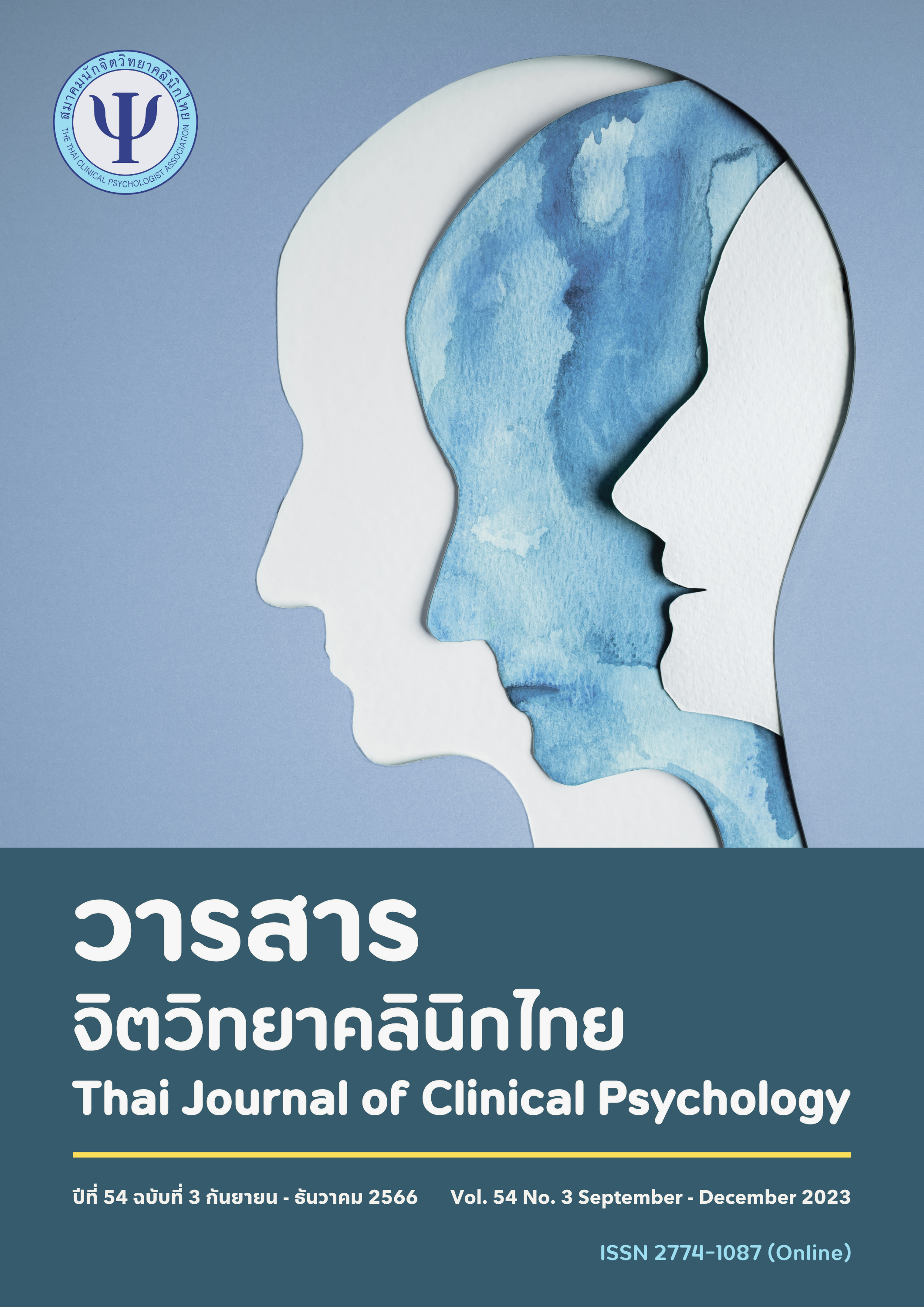ปัจจัยที่เกี่ยวข้องกับภาวะหมดไฟทางการเรียนของนักศึกษาระดับปริญญาตรี มหาวิทยาลัยรามคำแหง ภายใต้การดำเนินชีวิตในยุควิถีใหม่
Main Article Content
บทคัดย่อ
วัตถุประสงค์ 1) เพื่อศึกษาความสัมพันธ์ระหว่างภาวะหมดไฟทางการเรียนกับความสามารถในการเผชิญปัญหาอุปสรรค การรับรู้ความเครียด ความวิตกกังวลต่อโควิด19 และ 2) เพื่อศึกษาปัจจัยที่เกี่ยวข้องกับภาวะหมดไฟทางการเรียนของนักศึกษาภายใต้การดำเนินชีวิตในยุควิถีใหม่ วัสดุและวิธีการ กลุ่มตัวอย่างเป็นนักศึกษาระดับปริญญาตรี มหาวิทยาลัยรามคำแหง จำนวน 494 คน คำนวณขนาดกลุ่มตัวอย่างโดยโปรแกรม G*Power เก็บข้อมูลด้วยแบบสอบถามออนไลน์ สถิติที่ใช้วิเคราะห์ข้อมูลได้แก่ ความถี่ ร้อยละ ค่าเฉลี่ย ส่วนเบี่ยงเบนมาตรฐาน สัมประสิทธิ์สหสัมพันธ์ของเพียร์สันและการวิเคราะห์ถดถอยพหุแบบขั้นตอน ผลการศึกษา พบว่า 1) การรับรู้ความเครียด และความวิตกกังวลต่อโรคโควิด19 สัมพันธ์กับภาวะหมดไฟทางการเรียนระดับปานกลาง(r = .41; p < .01) และระดับต่ำ(r = .09; p < .05) ตามลำดับ ส่วนภาวะหมดไฟในการเรียนกับความสามารถในการเผชิญปัญหาอุปสรรค 4 ด้าน ได้แก่ การควบคุมสถานการณ์ การรับรู้สาเหตุและความรับผิดชอบต่อปัญหา การรับรู้ผลกระทบของปัญหา และความอดทนต่อปัญหา สัมพันธ์กับภาวะหมดไฟทางการเรียนระดับต่ำ (r = -.17, r = -.15, r = -.29, r = -26; p < .01) ตามลำดับ 2) ปัจจัยด้านการรับรู้ความเครียด การรับรู้ผลกระทบของปัญหา และความอดทนต่อปัญหาอุปสรรค สามารถร่วมกันทำนายภาวะหมดไฟทางการเรียนได้ร้อยละ19 มีนัยสำคัญทางสถิติ (β = .37,-.23 และ .14; p < .01) ตามลำดับ สรุป การรับรู้ความเครียด การรับรู้ผลกระทบของปัญหา และการควบคุมสถานการณ์ปัญหา เป็นตัวแปรที่สามารถร่วมกันทำนายภาวะหมดไฟทางการเรียนได้ ข้อสรุปนี้นำมาเป็นแนวทางในการจัดกิจกรรมเสริมหลักสูตรเพื่อป้องกันการเกิดภาวะหมดไฟทางการเรียนของนักศึกษาในอนาคตได้
Article Details

This work is licensed under a Creative Commons Attribution-NonCommercial-NoDerivatives 4.0 International License.
เรื่องที่ลงตีพิมพ์ในวารสารจิตวิทยาคลินิกแล้วถือเป็นลิขสิทธิ์การเผยแพร่โดยวารสารจิตวิทยาคลินิกแต่เพียงผู้เดียว การตีพิมพ์หรือเผยแพร่ซ้ำในที่อื่นต้องได้รับอนุญาตจากกองบรรณาธิการวารสารฯ
References
Asghari, A., Saadati, S. M., Ghodsi, A., & AzizFard, F. (2015). Review the academic burnout and its relationship with self-esteem in students of medical sciences university at Neyshabour. Scholars Journal of Applied Medical Sciences,
(9C), 3329-3334.
Aung, P., & San, A. (2020). Adversity quotient and academic stress of students from universities of education. Journal of the Myanmar Academy of Arts and Science, 18, 647-658.
Fortin, V. T. (2019). Adversity quotient and academic performance of senior high school: Basis for an intervention program [Unpublished master’s thesis]. St. Michael’s college Iligan.
Fosslien, L., & Duffy, M. W. (2020). How to combat zoom fatigue. Harvard Business Review, 29,1-6.
Jirawatkul, A. (2015). Statistics in health science for research. Wittayapat. (in Thai).
Jung, I., Kim, J. H., Ma, Y., & Seo, C. (2015). Mediating effect of academic self-efficacy on the relationship between academic stress and academic burnout in Chinese adolescents. International Journal of Human Ecology, 16(2),
-77.
Maslach, C, & Leiter, M. P., (1997). The truth about burnout. Jossey-Bass Publishers.
Ministry of Public Health, Department of Mental Health. (2020). Screening form for anxiety about
the COVID-19 virus. https://www.dmh.go.th/test/covid19/covid19/ (in Thai).
Ministry of Public Health, Department of Mental Health. (2021). The result of the mental health survey: Studying online makes children burnout.https://dmh.go.th/news-dmh/view.asp?id=31151 (in Thai).
Ministry of Public Health. (2023). Coronavirus infection situation daily update. https://ddc.moph.go.th/covid19-dashboard/ (in Thai).
National Research Institute. (2022). Report on the situation of COVID-19 infection. https://covid19. nrct.go.th/daily-report-30sep2022/ (in Thai).
Promsan T. (2021). Academic burnout of medical student in the 4th Naresuan. CMU Journal of education, 5(3), 1-10. (in Thai).
Ramkhamhaeng University. (2021). The report is statistics about undergraduate students. http://www.regis.ru.ac.th/10-2021-12-20-06-46-50/20-stat. (in Thai).
Safarzaie, H., Nastiezaie, N., & Jenaabadi, H. (2017).The relationship of academic burnout and academic stress with academic self-efficacy among graduate students. The New Educational Review, 49, 65-76.
Safii, A., Muttaqin, I., Hamzah, N., Chotimah, C., Junaris, I., & Rifa'i, M. K. (2021). The effect of the adversity quotient on student performance, student learning autonomy and student achievement in the COVID-19 pandemic era:
Evidence from Indonesia. Heliyon, 7(12), e08510.
Sanitlou, N., Sartphet, W., & Naphaarrak, Y. (2019). Calculating sample size with G*Power program. Journal of Suvarnabhumi Institute of Technology (Humanities and Social Sciences), 5(1), 496-507.
Simmonds, P. (2017). Testing the preliminary agreement of linear regression analysis. Journal of Research and Curriculum Development, 7(2), 20-37. (in Thai).
Stoltz, P.G. (1997). Adversity quotient: Turning obstacles into opportunities. John Wiley & Son.
Verma, S., Aggarwal, A., & Bansal, H. (2017). The relationship between emotional intelligence (EQ) and adversity quotient (AQ). IOSR Journal of Business and Management, 19(1), 49-53.
Wongpagarun, N., & Wongpagarun,T. (2010). The Thai version of the PSS-10: An investigation of its psychometric properties. Biopsychosocial Medicine, 4(6). 4-6.
West, C. P., Dyrbye, L. N., Erwin, P. J., & Shanafelt, T. D. (2016). Interventions to prevent and reduce physician burnout: A systematic review and meta-analysis. The Lancet, 388(10057), 2272-2281.

